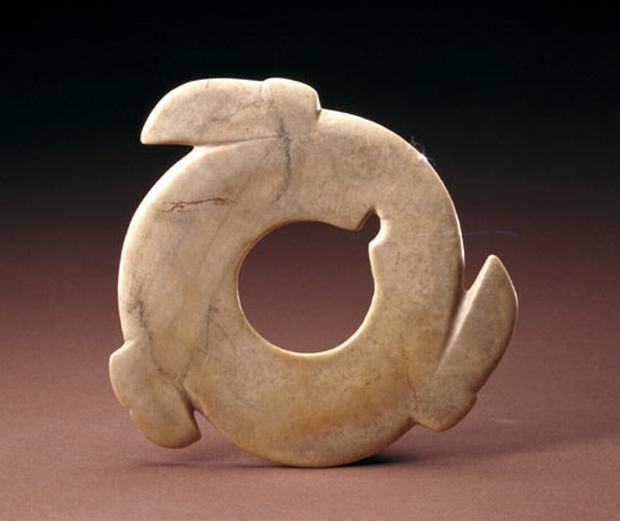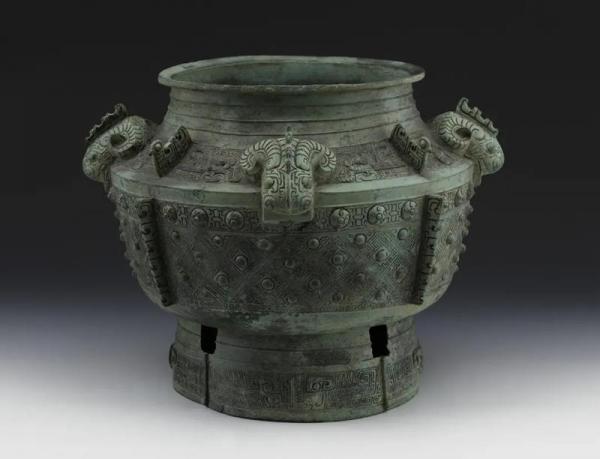Xia and Shang Dynasties
The Xia Dynasty of China, about 2100 BC to 1600 BC, is the first dynasty of Chinese history to be described in ancient historical records. The establishment of Xia Dynasty marked the end of primitive society and the beginning of the class society.
It was a state existed in the Yellow River Plain in the present provinces of Shandong, Shanxi and Shaanxi. The earliest discovered written record of China's past dates from the Shang Dynasty in the 13th century BC. All the things were recorded on the bones or shells of animals - so-called oracle bones.

Shang Dynasty, also known as Yin and Yin Shang, was the second dynasty in Chinese history and the first dynasty in China with direct written records and archaeological evidence. Shang Tang, the leader of the Shang tribe in a vassal state of Xia Dynasty, led his tribe to destroy Xia in the Battle of Mingtiao and established the regime in Bo (now Shangqiu). After his descendant Pan Geng moved to Yin (now Anyang), the regime became known as "Yin Shang". From 1600 BC to 1046 BC, it experienced three major stages. According to legend, there were 31 kings of the 17 generations, which lasted for nearly 600 years. The last king, King Zhou (纣) of Shang, committed suicide after having been defeated by King Wu of Zhou (周) at the Battle of Muye. The Shang Dynasty is believed to be the peak time of Chinese ancient slavery society. The slave owners and nobles were the ruling class, controlling the bureaucratic system and army.
Shang Dynasty Facts
In Chinese: 商朝
Time period: About 1600BC – about 1046BC
Capital:
1.Bo (亳), current Shangqiu, Henan Province.
2.Xiao (嚣), current Zhengzhou, Henan Province
3.Xiang (相), current Zhengzhou, Henan Province
4.Yin (殷), current Anyang, lasting for 273 years
Population: estimated 7-15 million
First King: Shang Tang (Cheng Tang)
Last King: Di Xin (King Zhou)
The Shang Kingdom is estimated to cover an area of about 3.2 million square kilometers. The territory of Shang Dynasty expanded a lot on the basis of the previous Xia Dynasty, reaching Liaoning in the north, Hubei in the south, Shaanxi in the west, and seashore in the east.
However, the Shang Dynasty did not form a complete unified state, and its territory was only an approximate sphere of influence. Only the central and northern parts of Henan were directly controlled by the Shang Dynasty. Other areas belonged to the vassal states and tribes, which were not under the direct administration of Shang Dynasty.
Shang Dynasty Kings– Timeline with Years
| Reign Title | Dynastic Title | Name of the King | Reign Years | Remarks |
| Shangtang | Shang Gaozu | Lü | 13 | |
| Taiding | He died before accessing to the throne. | |||
| Waibing | Shang Aiwang | Sheng | 2 | |
| Zhongren | Shang Yiwang | Yong | 4 | |
| Taijia | Shang Taizong | Zhi | 12 or 23 | |
| Woding | Shang Zhaowang | Xuan | 29 | |
| Taigeng | Shang Xuanwang | Bian | 35 | |
| Xiaojia | Shang Jingwang | Gao | 17 | |
| Yongji | Shang Yuanwang | Zhou | 12 | |
| Taiwu | Shang Zhongzong | Mi | 75 | |
| Zhongding | Shang Xiaochengwang | Zhuang | 13 | |
| Wairen | Shang Siwang | Fa | 15 | The Shang began to decline. |
| Hedanjia | Shang Qianpingwang | Zheng | 9 | |
| Zuyi | Shang Muwang | Teng | 19 | |
| Zuxin | Shang Hengwang | Dan | 16 | |
| Wojia | Shang Xiwang | Yu | 20 | |
| Zuding | Shang Zhuangwang | Xin | 9 | |
| Nangeng | Shang Qingwang | Geng | 6 | |
| Yangjia | Shang Daowang | He | 7 | There was a lot of internal strife during his reign. |
| Pangeng | Shang Shizu | Xun | 28 | The capital was moved to Yin. The Shang revived. |
| Xiaoxin | Shang Zhangwang | Song | 3 | |
| Xiaoyi | Shang Huiwang | Nian | 10 | |
| Wuding | Shang Gozong | Zhao | 59 | |
| Zugeng | Shang Houpingwang | Yue | 11 | |
| Zujia | Shang Shizong | Zai | 33 | |
| Linxin | Shang Jiazong | Xian | 6 | |
| Kangding | Shang Kangzu | Xiao | 8 | |
| Wuyi | Shang Wuzu | Qu | 35 | |
| Taiding | Shang Kuangwang | Tuo | 13 | |
| Diyi | Shang Dewang | Xian | 26 | |
| Dixin | Shang Zhouwang | Shou | 30 | The last king of Shang Dynasty, a controversial ruler. |
Shang Dynasty Arts: Bronze ware, Jade ware
The Shang Dynasty is the period of prosperity for Chinese bronze wares. Many bronze wares of the early Shang Dynasty were unearthed in Zhengzhou, because Shangcheng of Zhengzhou was the capital of the early Shang Dynasty. These bronzes are generally scattered in the south and southeast corners of the area, where a number of ancient tombs or cellars were excavated here. There were also significant discoveries of bronze wares found in northern Henan, Huangpi Panlongcheng of Hubei, Bogang in Jiashan of Anhui, and Wucheng in Qingjiang of Jiangxi. From the unearthed bronze wares, we can see the obvious improvements in modeling design, pattern decoration and casting technology compared with the previous Xia dynasty. During this period, the types of ritual vessels increased, and animal-faced pattern appeared on the main body of the wares, some initially with inscriptions.

The Late Shang Dynasty refers to the period after Pan Geng moved his capital to Yin, known as the period of Yin Ruins. With the development of smelting and casting technologies, the bronze wares were decorated with more different patterns in the stage, with much richer content and types than the former period. The animal face patterns were further developed and became a unique model of ancient decorative art. The bronze wares of Shang Dynasty stood at the unprecedented height during the ancient slavery era in China. The creative experience directly influenced various art categories at that time.
Due to the use and upgrading of bronze tools in the field of jade carving, the burgeoning bronze manufacturing industry provided important guarantees for the development of jade carving technology, which made the art form reach a very high artistic standard and led to the first peak in the history of jade ware development. From then on, Chinese jade culture has gradually come into being on the land of this country.
Shang Dynasty jade wares were heavily influenced by the patriarchal ritual system, and became a treasure monopolized by the kings and nobilities, with wide varieties. In addition to religious vessels, there are also jade tools, jade ornaments and jade utensils for daily use and display. The most precious jade wares unearthed from ancient relics are ritual implements and human figures. The appearance, pattern and design of these works can reflect various aspects of the society during Shang Dynasty. Therefore, these jade wares are thought to have higher artistic and economic value due to the difficulties of carving. Generally speaking, we can find more different types of jade tools, utensils and weapons, with lower artistic value, while the ritual implements were more finely made with the unique shapes.
Shang Dynasty Achievements & Inventions
Oracle bone script mainly refers to Chinese ancient characters engraved on animal bones and tortoise shells. It is the earliest and relatively complete writing system discovered in China. Most of these oracle bone inscriptions are divination records of Shang rulers. So far, more than 4,600 characters have been found on these oracles, and the current scholars have recognized more than 1,000 ones. Although these characters are quite different from the ones Chinese people use now, both have many similarities in creating the characters. For example, the look of oracle bone script is always in a square font because they had to be carved on the hard material. This feature has not been changed in the history of Chinese writing for thousands of years.
The Shang people paid much attention to observing astronomical phenomena, and there were many records about celestial phenomena mentioned on the oracles from Yin Ruins, including records of solar and lunar eclipses. They also noticed the fixed stars and had the earliest observation record of novae in the world.
On the basis of the Xia Dynasty calendar, the Shang People integrated the solar and lunar calendars, so that their calendar became more accurate and feasible. According to the narrative on oracles, each year had 12 months: the long month of the Yin calendar had 30 days, and the short month was 29 days. As we know, the solar and lunar calendars have different numbers of days in a year. In order to coordinate the contradiction between the tropical year and the lunar year, an intercalary month would be added in a year (usually every two or three years). It was the Shang/Yin calendar that laid the foundation for the traditional Chinese calendar.
Mathematical achievements: the numbers carved on the oracle bones of Shang Dynasty have clarified the concepts of decimal system, odd/even number and multiples that we are familiar with today. This means the Shang people already had basic calculating capabilities.
Shang Dynasty Clothing: Hairstyles, Dress, Hat and other Fashion
Clothes
The clothes of the Shang people were mainly made of 2 parts: the top and bottom (upper body and lower body clothes). With their length to the knees or so, the tops usually had small sleeves unlike those in the later dynasties. The female clothing was generally the same style as that of men during the Shang Dynasty.
Head dress
In Shang Dynasty, men usually folded head scarves up into a long ribbon and wrapped around their head, like a headband. In winter, thick cloth or leather hats are used instead. For noble women, they tended to have a jade hair stick or other ornaments placed on the head.
Shoes
The Shang people usually made the hemp and ramie as the shoe vamp, with leather and hemp as the sole, and of course some were made of wood.
Material
According to the records of the oracle bone inscriptions, the materials of clothes in the Shang Dynasty were mainly different kinds of silk for the upper class. This proves that the Shang people wore silk clothes and leather robes. As to the ordinary people, the scholar estimated that they wore hemp or ramie clothes.
According to the archaeological discoveries, the colors of fabrics in the Shang were mostly warm colors, especially yellow and red, with a little brown sometimes, but cold colors such as blue and green also appeared. During Shang dynasty, dyeing and painting were often used together. After the fabrics were woven, they were often painted with hand brushes.
Shang Dynasty Architecture
Since the Shang Dynasty existed more than 3000 years ago, currently we can’t find any surface building constructed during that period. It is because ancient Chinese lived in adobe houses, some with wooden frames, this means all these buildings are not durable and strong as those stone ones. What we can see now are the unearthed archaeological sites of Shang Dynasty in different parts of China, which are mostly located in Henan Province. The most famous ancient remain of the Shang era is Yin Xu (Yin Ruins) of Anyang in the north of Henan, which was added to the UNESCO World Cultural Heritage list in 2006.
An Interesting Question: why in China we call the merchants “Shang People” (Shangren), and commerce or trade “Shang Business” (Shangye)?
Please see the characters and related words, you can find an interesting thing.
Shang Dynasty 商朝
Shang Ren, 商人, literally refers to the people from Shang tribe in history, later it refers to merchants
Shang Ye, 商业, literally means the practice Shang people do, later it refers to trade and commerce
Shang Ren originally referred to the members of the "Shang" tribe in the Xia Dynasty, whose ancestor was called "Qi”, who was enfeoffed in Shangyi because he helped Da Yu King (the founder of Xia Dynasty) to harness floods. In the mid-Xia Dynasty, a remarkable figure emerged from the Shang tribe - Wang Hai. He not only learned to raise livestock, but also tame cattle and horses. He invented the double-shaft ox carts, which replaced the manpower transportation with oxen.
With the advent of new means of transportation, Wang Hai could travel to many different places. He found that each tribe would have something they needed from other tribes, but due to the inaccessibility, the exchange was difficult to complete. So he became a middleman, and he often led his slaves to the tribes on the north bank of the Yellow River with his ox carts to do business.
As soon as the local people of other tribes saw Wang Hai, they knew that someone with good things had come again. Then they shouted joyfully to their fellow tribesmen: "The Shang people are here". It is because of Wang Hai's ongoing trade among various tribes that the Shang tribe gradually became stronger and wealthier. Later, when he was trading with the Youyi tribe north of the Yellow River, he was killed by Mianchen, the ruler of the tribe. His son Shang Jiawei killed Mianchen for revenge four years after his father’s death.
By the time of Shang Tang’s reign over his tribe, the handicraft industry of the Shang people was quite developed, especially the textile industry, which became the envy of other tribes. In order to achieve his ultimate goal, Shang Tang ordered the tribal women to spin yarn and weave cloth as much as possible, and exchanged the textile for a large amount of grains from the Xia Dynasty. Later, Shang Tang led his tribe to overthrow the regime of the Xia Dynasty and established the Shang Dynasty.
But about 600 years later, the Shang Dynasty was eventually overturned by King Wu of Zhou. After the establishment of Zhou Dynasty, the people of Shang tribe instantly dropped from nobles to slaves. King Wu ordered to move all the Shang people to Luoyang area and put them under strict supervision.
These people were not allowed to own any land, so they started their old job – trading again. At that time, the nobles of the Zhou Dynasty were disdainful of such kind of low-level work, and the peasants were not allowed to engage in commercial activities. So doing trade can only be done by Shang people. Since these people traveled around, and most of them were from Shang tribe, this is why later people called the merchants “Shang Ren” (Shang people), and what they did is called Shang Ye (Shang people’s career – trade)
Recomended China history Tours:
You May Also Be Interested In:


